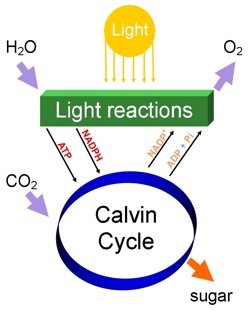NUTRITION AND ADAPTATIONS
2009
Cinnamon zeylanicum is a member of the Kingdom Plantae. All plants beside a few heterotrophic species acquire their nutrients by means of photosynthesis. The simplified diagram to the right explains the basic processes of photosynthesis. To learn more about the process of photosynthesis click here. Cinnamon is an autotroph who uses organic molecules like CO2 and other inorganic raw materials. It requires water and minerals from the soil plus carbon dioxide and sunlight.
A Cinnamon Tree Photosynthesizes like all Other Trees.
The tree produce sugar molecules which other organisms besides itself benefit from. See the page on species interactions. As long as C. zeylanicum is growing in a habitat suited to its needs, it does not have to overcome any problems. Cinnamon is a natural producers in its environment and provides not only just sugars but is constantly omitting oxygen out into the environment.
Cinnamomum zeylanicum has the potential to be a host to many other various species. It is an excellent source of nutrients for many birds, insects, or other herbivores that feed on the plant, and also provides a habitat for these same similar species.
Cinnamon is a vascular plant and therefore has vascular tissues such as xylem and phloem. Each are composed of more than one cell type and are found in vascular bundles. Xylem moves water up from the roots to the shoots, while phloem moves sugars from the leaves, typically at the top of the tree, down to the roots. Cinnamon uses these two vascular tissue along with adhesion, cohesion, and waters natural movement from high water potential to low water potential, to transport nutrients and water throughout its entire body. To learn more about this process click here.
In nature, Cinnamomum zeylanicum produces a dense canopy, an adaptation that has allowed them to dominate the forests they grow in. Their dense canopy blocks out sunlight and prevents the growth of any vegetation below. They have also adapted to growing quickly and producing many seeds, another trait that prevents any native species from growing around them. Clearly this species is rooted to the ground and cannot move to a different environment, however, this species produces many seeds. These seeds can be carried by wind, animals, or to other means until they land in a favorable environment. Once in that environment, the seed will germinate and grow into a new tree. However, to increase its numbers, cinnamon has also adapted a shade tolerance and can invade undisturbed forests unlike some species. Want to know some other fun facts about cinnamon?



